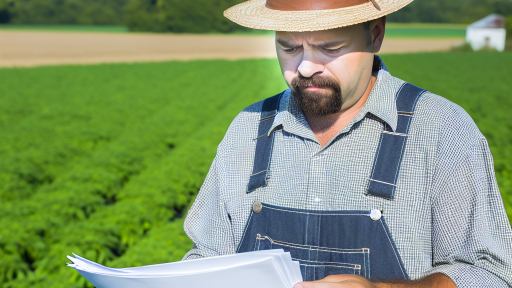Overview of Research and Development in Agriculture
Research and development (R&D) play a vital role in agriculture.
This sector faces unique challenges which need innovative solutions.
Consequently, R&D efforts focus on improving crop yields and resilience.
Advancements in technology boost productivity and sustainability.
For instance, precision agriculture enhances resource use efficiency.
Importance of R&D in Agricultural Innovation
Innovation keeps agriculture competitive in a changing market.
Without R&D, businesses struggle to adapt to climate change issues.
Furthermore, R&D helps in developing pest-resistant crops.
These innovations contribute significantly to food security.
Investing in R&D leads to more profitable agricultural practices.
Key Areas of Focus in Agricultural Research
Various areas receive attention within agricultural research.
- Soil health and conservation methods
- Crop biotechnology and genetic modification
- Water management and irrigation efficiency
- Integrated pest management strategies
Each area addresses specific challenges faced by farmers.
Moreover, they contribute to long-term sustainability efforts.
Collaborative Efforts in Agricultural R&D
Collaboration is essential for successful R&D initiatives.
Partnerships between private companies and research institutions thrive.
Transform Your Agribusiness
Unlock your farm's potential with expert advice tailored to your needs. Get actionable steps that drive real results.
Get StartedSuch collaborations enhance knowledge sharing and resource allocation.
For example, the Agricultural Research Service often partners with universities.
This collaboration accelerates the development of innovative technologies.
Funding Sources for Agricultural R&D
Numerous funding sources support agricultural research projects.
- Government grants and subsidies
- Private investment from corporations
- Non-profit organizations with agricultural missions
- Research foundations and international funding bodies
These funding sources ensure that vital research continues.
Moreover, they provide the necessary resources for groundbreaking innovations.
Government Grants and Subsidies for Agricultural Innovation
Understanding Government Support
Government grants and subsidies play a crucial role in supporting agricultural innovation.
These financial resources help farmers and agribusinesses invest in new technologies.
By lowering the financial burden, government programs encourage research and development.
This support fosters a more sustainable and efficient agricultural sector.
Types of Government Grants
Several types of grants exist to support agricultural businesses.
For instance, competitive grants require proposals that demonstrate innovation potential.
Non-competitive grants provide funding based on meeting specific criteria.
Additionally, cost-sharing grants reduce the total investment required by the business.
Each type of grant serves different needs within the agricultural community.
Eligibility Criteria
Eligibility for government grants varies by program.
Most grants require that applicants meet specific agricultural or environmental criteria.
Businesses must also demonstrate their capacity for innovation.
Therefore, understanding the eligibility requirements is crucial for applicants.
Notable Government Programs
Several government programs offer grants for agricultural innovation.
The Agricultural Research Service (ARS) provides funding for research projects.
The Small Business Innovation Research (SBIR) program also supports agricultural startups.
Programs like the Sustainable Agriculture Research and Education (SARE) fund educational projects.
Each program has unique goals and funding levels.
Showcase Your Farming Business
Publish your professional farming services profile on our blog for a one-time fee of $200 and reach a dedicated audience of farmers and agribusiness owners.
Publish Your ProfileApplication Process
Applying for government grants requires careful planning and documentation.
First, applicants must identify the right grant for their needs.
Next, they should prepare a comprehensive proposal outlining their project.
Finally, reviewing submission guidelines is essential to avoid common pitfalls.
Benefits of Government Funding
Government funding offers numerous benefits to agricultural businesses.
It reduces financial risks associated with new research and development projects.
Moreover, it can improve access to advanced technologies and practices.
Government support also enhances the credibility of the recipient organization.
Consequently, successful grant recipients often attract additional investors.
Private Sector Investments in Agricultural Technology
Overview of Private Sector Involvement
The private sector plays a vital role in agricultural research and development.
Investments by companies drive innovation in agricultural technology.
Furthermore, these investments underwrite significant advancements in productivity.
Types of Private Sector Investments
Private funding can be categorized into several key areas.
Venture capital funds focus on startup agricultural technologies.
Corporate investments often target established firms with promising innovations.
Philanthropic contributions can enhance agricultural research initiatives.
Examples of Successful Private Investments
Many companies have made impactful investments in agriculture.
For instance, AgTech Innovations invested heavily in precision farming tools.
This investment enabled farmers to optimize their yields significantly.
Additionally, Green Future Labs developed sustainable irrigation solutions.
Their funding transformed water management practices among local farmers.
Collaboration with Research Institutions
Many private sector firms collaborate with academic institutions.
Such partnerships enhance research efforts and results.
Firms gain access to cutting-edge research while providing funding.
For example, BioAgra partnered with the University of Agriculture on a biotech project.
This collaboration resulted in breakthroughs in pest-resistant crops.
Challenges in Attracting Investments
Despite the funding opportunities, challenges remain in attracting investments.
Investors often face risks related to market uncertainties.
Moreover, fluctuating agricultural prices can deter long-term investments.
Lastly, the need for regulatory approvals can delay innovation.
Future Trends in Agricultural Investments
Technological advancements will continue shaping agricultural investments.
Investments in artificial intelligence applications are on the rise.
Moreover, sustainable agricultural practices attract more funding.
Investors increasingly focus on climate-resilient farming technologies.
Lastly, the use of blockchain technology for supply chain transparency is expanding.
Learn More: How Government Policies Influence Agricultural Insurance
Role of Agricultural Cooperatives in Funding R&D Projects
Importance of Agricultural Cooperatives
Agricultural cooperatives play a vital role in funding research and development projects.
They unite farmers to achieve common goals regarding innovation.
By pooling resources, these cooperatives can allocate funds efficiently for research initiatives.
Source of Funding
Agricultural cooperatives generate funding through various channels.
Showcase Your Farming Business
Publish your professional farming services profile on our blog for a one-time fee of $200 and reach a dedicated audience of farmers and agribusiness owners.
Publish Your ProfileMember contributions form the foundation of their financial resources.
Additionally, cooperatives often secure grants from government and private organizations.
These funds enable them to support innovative R&D projects.
Collaboration with Research Institutions
Cooperatives frequently collaborate with research institutions and universities.
This collaboration facilitates knowledge exchange and shared resources.
By working together, they can tackle pressing agricultural challenges more effectively.
Furthermore, such partnerships enhance the credibility of R&D efforts.
Example Initiatives
Several successful initiatives demonstrate the impact of cooperative funding.
- The Green Earth Cooperative funded a statewide soil health program.
- Harvest Alliance launched a crop improvement project in collaboration with local universities.
- Farmers United developed a pest management solution using cooperative resources.
These examples showcase tangible benefits that stem from cooperative funding strategies.
Challenges Faced
Despite their advantages, cooperatives face certain challenges in funding R&D.
Resource allocation can become complicated due to diverse member interests.
Moreover, securing grants often requires extensive paperwork and follow-up.
Cooperatives must navigate these hurdles to maximize their impact.
Future Prospects
The role of agricultural cooperatives in funding R&D projects continues to grow.
As agriculture becomes more technology-driven, funding needs will increase.
Cooperatives will likely serve as a crucial link between farmers and research entities.
Improving funding mechanisms will enhance their effectiveness in driving agricultural innovation.
Learn More: Guide to Renewable Energy Grants for Farmers
Universities and Research Institutions as Funding Sources
Role of Universities in Agricultural Funding
Universities play a vital role in funding agricultural research and development.
They often have dedicated funds for grants and research projects.
Moreover, universities collaborate with agricultural businesses for mutual benefits.
This collaboration can lead to innovative solutions and enhanced productivity.
Research Institutions and Their Impact
Research institutions provide significant funding opportunities for agricultural projects.
They focus on addressing pressing agricultural challenges through research.
These institutions often partner with governments and private sectors.
Additionally, they offer resources and expertise to help businesses grow.
Grant Opportunities Available
Various grants are available from universities and research institutions.
- National Institute of Food and Agriculture grants support various projects.
- Local university grants often cater to regional agricultural issues.
- Collaborative grants involve partnerships between universities and industry.
Each of these grants has specific eligibility criteria and application processes.
Therefore, businesses should carefully review requirements before applying.
Networking for Funding Access
Networking remains essential for accessing funding opportunities.
Universities and research institutions often host events for collaboration.
Attending these events helps businesses connect with potential funders.
Furthermore, building relationships with researchers can lead to funding insights.
Successful Case Studies
Examining successful funding projects can provide valuable lessons.
For example, the Agri-Food Innovation Centre successfully obtained multiple grants.
This funding allowed them to develop sustainable farming practices.
Such case studies highlight the potential benefits of engaging with these institutions.
Delve into the Subject: The Role of Food Safety Standards in Farm Management

International Organizations and NGOs Supporting Agricultural Research
Role of International Organizations
International organizations play a pivotal role in agricultural funding.
The Food and Agriculture Organization (FAO) provides essential support worldwide.
Showcase Your Farming Business
Publish your professional farming services profile on our blog for a one-time fee of $200 and reach a dedicated audience of farmers and agribusiness owners.
Publish Your ProfileAdditionally, the International Fund for Agricultural Development (IFAD) funds projects in developing countries.
These organizations promote sustainable farming practices to enhance productivity.
They also focus on improving food security and rural development.
Key Non-Governmental Organizations
Numerous NGOs actively contribute to agricultural research funding.
The International Rice Research Institute (IRRI) focuses on rice production improvements.
Similarly, the Consultative Group on International Agricultural Research (CGIAR) supports research on various crops.
These NGOs collaborate with local farmers to implement innovative practices.
Moreover, they address climate change impacts on agriculture.
Partnerships and Collaboration
Partnerships between organizations enhance funding opportunities.
Collaborative projects often yield better results in agricultural research.
For instance, NGOs may partner with the World Bank to tackle food insecurity.
This teamwork leverages resources for maximum impact.
Furthermore, joint initiatives often lead to shared knowledge and technology.
Funding Mechanisms
Various funding mechanisms support agricultural research and development.
Grants and loans from international organizations provide vital resources.
NGOs also offer funding through competitive grants and donations.
These financial tools enable projects that focus on sustainable practices.
Importantly, transparency in funding fosters trust among stakeholders.
Impact on Agricultural Resilience
International organizations and NGOs significantly impact agricultural research funding.
Their efforts ensure advancements in farming techniques and food production.
These collaborative networks enhance agricultural resilience worldwide.
Uncover the Details: Evaluating Alternatives To Traditional Pesticides
Venture Capital and Start-up Funding for Ag-tech Innovations
Overview of Venture Capital in Agriculture
Venture capital plays a vital role in agricultural technology startups.
In recent years, investments in ag-tech have surged significantly.
These investments fuel innovation and support sustainable practices.
Furthermore, they enable entrepreneurs to bring ideas to market rapidly.
Attracting Venture Capital Investment
To attract venture capital, startups must present compelling business models.
Investors look for innovative solutions that address pressing agricultural challenges.
Moreover, a strong management team boosts credibility with potential investors.
Networking and industry connections can also enhance visibility.
Key Players in Ag-tech Venture Capital
Several prominent firms specialize in ag-tech investments.
For instance, AgFunder focuses exclusively on food and agriculture startups.
Similarly, Blue Horizon invests in sustainable food and agriculture solutions.
In addition, investment groups like The Climate Pledge Fund support eco-friendly innovations.
Types of Funding Available
Startups can explore various funding avenues within venture capital.
Seed funding often supports initial concept development and prototyping.
Series A funding typically helps companies scale their operations.
In contrast, later funding rounds can further expand market reach and product offerings.
Challenges in Securing Venture Capital
While opportunities abound, securing funding can be challenging.
Competition for venture capital is intense in the agricultural sector.
Showcase Your Farming Business
Publish your professional farming services profile on our blog for a one-time fee of $200 and reach a dedicated audience of farmers and agribusiness owners.
Publish Your ProfileAdditionally, early-stage startups may struggle to articulate their vision.
Investors might also prioritize quick returns, which can pressure startups.
Success Stories in Agricultural Start-ups
Success stories exemplify how venture capital can transform ag-tech.
For example, Plenty has revolutionized vertical farming with innovative technology.
Another notable success is Bowery Farming, which received significant venture funding.
These companies demonstrate the potential for growth and impact in agriculture.
Crowdfunding Platforms for Agricultural Projects
Overview of Crowdfunding
Crowdfunding has transformed funding for agricultural projects.
This method enables businesses to raise capital directly from the public.
Essentially, it democratizes the funding process.
Farmers and agribusinesses can present their ideas to a wide audience.
Backers can choose to support projects that resonate with them.
Types of Crowdfunding
There are several types of crowdfunding available.
Donation-based crowdfunding allows people to give without expecting returns.
Rewards-based crowdfunding offers backers tangible returns for their support.
Equity crowdfunding lets backers invest in projects in exchange for shares.
Each type caters to different funding needs and stakeholder preferences.
Popular Crowdfunding Platforms
Many platforms support agricultural projects.
Kickstarter is a well-known rewards-based platform.
Indiegogo offers flexible funding options for creators.
Farmers are increasingly turning to platforms like Barnraiser.
These platforms focus specifically on food and agriculture-driven projects.
Kickstarter
Kickstarter allows agricultural entrepreneurs to showcase creative ideas.
Success hinges on engaging storytelling and attractive rewards.
The platform facilitates access to a vast network of potential backers.
Indiegogo
Indiegogo functions similarly but offers more flexible funding options.
Campaigns can continue even after the initial funding goal is met.
This flexibility attracts diverse projects in the agricultural sector.
Barnraiser
Barnraiser connects food and farm projects with community backers.
This platform emphasizes sustainability and local farming initiatives.
Backers can choose projects that align with their values.
Benefits of Crowdfunding for Agriculture
Crowdfunding provides numerous advantages to agricultural businesses.
It allows for market validation before significant investment.
This practice encourages community engagement and support.
Additionally, it diversifies funding sources for farmers.
Ultimately, it reduces reliance on traditional financial institutions.
Challenges to Consider
Despite its benefits, crowdfunding has challenges.
Competing for attention on crowded platforms can be difficult.
Creating appealing marketing materials is crucial for success.
Also, ongoing communication with backers is essential.
Transparency can affect backer trust and future funding opportunities.
Showcase Your Farming Business
Publish your professional farming services profile on our blog for a one-time fee of $200 and reach a dedicated audience of farmers and agribusiness owners.
Publish Your ProfileAdditional Resources
Higher Education Research and Development (HERD) Survey 2022 …




